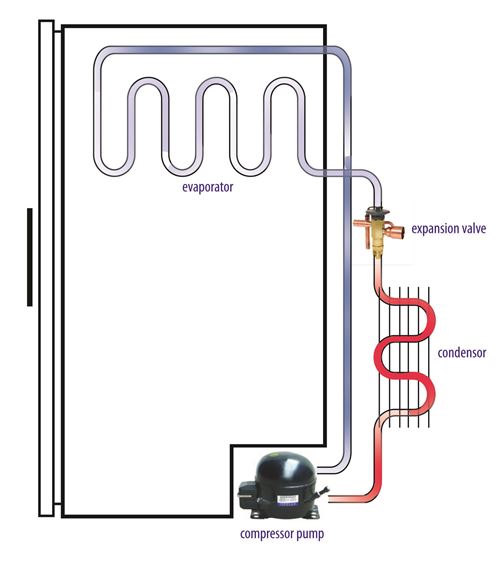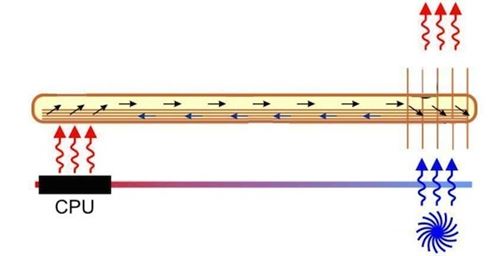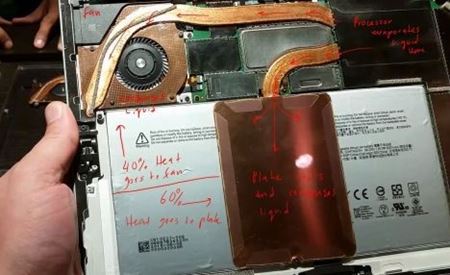Utilizing technology not too different than that present in your kitchen’s refrigerator, engineers are using heat pumps, heat sinks and heat pipes to cool off hot spots that threaten the performance of everything from satellites to smartphones.
As technology advances, thermal management is becoming more and more important. For many applications, a simple heat sink and fan can be enough, but for applications where components are really working and generating a lot of heat, additional steps are needed. Furthermore, few functions are more critical to modern electronic devices than saving energy, and this is true whether they are mobile devices subsisting on finite battery charges or parts of probes traveling through space. Although it sounds counterintuitive at first, systems such as these can take a large part of the cooling burden away from the fan without adding much system weight, and save a lot of the battery power that would have otherwise been devoted to cooling.
Have you ever doused a sore shoulder with rubbing alcohol and felt the instant cooling effect? That’s from the surface skin’s temperature heating the alcohol so that it changes from liquid to gas; the evaporation taking some of the skin’s heat away with it as the gas departs from the shoulder. Similarly, consider the many types of toiletries that are available in cans as pressurized gas that the consumer sprays on his or her body, with a resulting feeling of coldness. This is the result of the gas’s sudden decrease in pressure. These are the basic principals underlying both heat pumps and refrigeration.
How a refrigerator works

Figure 1: Basic refrigeration model. (Source: Charchitecture)
Looking at the illustration above, first notice the closed circuit from the compressor pump, through the condenser, the expansion valve, the evaporator, and finally, back to the compressor pump. The pump draws gas from the evaporator and pumps it into the condenser, which is the part outside of a refrigerator that’s warm to the touch. It’s warm because the gas condenses into a liquid at high pressure. The expansion valve slowly allows the high-pressure liquid into the evaporator, which is an area of low pressure due to action of the compressor, which has drawn gas into the condenser from the evaporator. In the evaporator—due to low pressure—the liquid vaporizes, creating the cooling effect. Finally, the compressor removes the gas from the evaporator, creating that low pressure, and the process continues.
How a heat pipe works
Heat pipes work a bit differently, and the most important difference is that they don’t require a pump. This makes them practical for use in power-stingy applications such as mobile electronics. And, in truth, it isn’t a particularly new idea, as it is an established technology for laptops.

Figure 2: Diagram of a heat pipe. (Source: eTray News)
At the CPU—or whatever overheating part that is being protected—liquid in the heat pipe is heated into vapor and absorbs the CPU’s excess heat, as indicated on the left side of the diagram by the red arrows. The heated vapor finds its way to the other end of the airtight pipe, which may touch a heat sink or, alternatively, it may be exposed to open air. It may or may not be assisted by a fan. In either case, it transfers its heat, as indicated by the second set of red arrows, and the gas reverts to a liquid.
Now, the liquid must be returned to the area of the heat sink in contact with the CPU. It does so by first entering a network of very narrow tubes called capillaries. Through a process known to physical scientists as capillary action, the liquid is drawn into the capillaries, and will travel a certain calculated distance, even against gravity. The system has been engineered so that the capillary action is sufficient to return the liquid to the CPU, and the cycle continues.
Your tablet now has a built-in heat pipe
Here’s what the heat pipe system looks like in Microsoft’s Surface Pro IV.

Figure 3: The heat pipe system within the Microsoft Surface Pro IV. (Source: Sean Org, Windows Central)
The liquid is water here. The heat of the CPU turns the water into steam, and the pipe transmits it to the device’s kickstand and to the fan, where it condenses back into water Because of the heat pipe circuit, the fan rarely has to run at all.
Heat pipes for spacecraft
Heat control systems for spacecraft face a dual mission. As in earth-based electronic devices, there are locations that need heat removed, but in addition—due to the conditions of extreme cold—there are other areas that need to have heat supplied. This presents some unique opportunities, as well as difficulties.
One of the difficulties is presented by the requirement for dual-loop systems. The first loop is similar to what we’ve already seen, which encompasses all the component parts within the spacecraft known to generate excess heat. At a central exchange point, there are two tasks to accomplish. One is to transfer the excess heat to the second loop, which brings heat to those areas that—exposed to the cold vacuum of space—need extra heat to function properly. The second is to radiate the heat that isn’t needed for heating into the void of space.
An important consideration for these types of systems is the safety of the human space voyagers, who will be present in the areas generating excess heat. This first loop must employ a non-toxic heat transport fluid to safeguard the crew in case of a leak. This loop—based on capillary action—can be quite similar on a basic level, to the systems described for terrestrial electronics.
When the topology of a spacecraft makes systems such as these a viable possibility, it presents a unique advantage to designers. There is an enormous savings in power made possible by using excess heat already being generated to provide heating for areas that need it, rather than the only other alternative—using scarce system power to generate that same heat. This leaves the power that would otherwise be taken up with heating free to power more instruments and on-board capabilities, and making more fruitful space missions possible, to the advantage of all.


